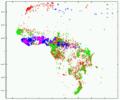Erik Rauch
| Erik Rauch | |
|---|---|
 | |
| Born |
Erik Rauch May 15, 1974 |
| Died |
July 13, 2005 (aged 31) California's Sequoia National Park United States |
| Nationality | American |
| Education |
Massachusetts Institute of Technology, Ph.D. Stanford University Yale University, B.S. in Computer Science and Mathematics |
| Occupation | Biophysicist and theoretical ecologist |
| Employer |
NECSI MIT Santa Fe Institute Yale University IBM Department of Ecology and Evolutionary Biology at Princeton University |
| Known for | Founder of MetaCarta, ALife, TerraShare |
Erik Rauch (May 15, 1974 – July 13, 2005) was a biophysicist and theoretical ecologist who worked at NECSI, MIT, Santa Fe Institute, Yale University, Princeton University, and other institutions. Rauch's most notable paper was published in Nature and concerned the mathematical modeling of the conservation of biodiversity.
Biography
He received a B.S. in Computer Science and Mathematics from Yale University in May 1996, where he was the technician for campus humor magazine The Yale Record.[1] His undergraduate thesis was "The Geometry of Critical Ising Clusters", under the direction of Benoit Mandelbrot, the inventor of fractal geometry. He then worked at the IBM Watson Research Center in the theoretical physics department, and began graduate study at Stanford University in 1996.
He received his PhD. from Massachusetts Institute of Technology in 2004 under the direction of Gerald Sussman: his thesis topic was " Diversity of Evolving Systems: Scaling and Dynamics of Genealogical Trees "
He then joined the Department of Ecology and Evolutionary Biology at Princeton University as a postdoctoral fellow in the group of Simon A. Levin, the Moffett professor of Biology in 2005, and was in that position at his early death.
His hobby of collecting place names led Rauch to found MetaCarta with John Frank and Doug Brenhouse. Using MetaCarta's software, Rauch developed maps like the four below for fun. Rauch was an inventor of spatial information processing systems.[2]
He founded several organizations, including
He died in a hiking accident in California's Sequoia National Park at age 31.[3]
Published works related to biological diversity
- Erik M. Rauch; Yaneer Bar-Yam (2006). "Long-range interactions and evolutionary stability in a predator-prey system". Physical Review E. 73. Bibcode:2006PhRvE..73b0903R. doi:10.1103/physreve.73.020903.
- Rauch, E.M. and Yaneer Bar-Yam (2005). "Estimating the total genetic diversity of a spatial field population from a sample and implications of its dependence on habitat area". Proceedings of the National Academy of Sciences of the United States of America. 102 (28): 9826–9829. Bibcode:2005PNAS..102.9826R. doi:10.1073/pnas.0408471102. PMC 1174974
 . PMID 15998741.
. PMID 15998741. - Erik M. Rauch; Yaneer Bar-Yam (2004). "Theory predicts the uneven distribution of genetic diversity within species". Nature. 431 (7007): 449–452. Bibcode:2004Natur.431..449R. doi:10.1038/nature02745. PMID 15386012.
- Erik M. Rauch H. Sayama and Yaneer Bar-Yam (2004). "Dynamics and genealogy of strains in spatially extended host-pathogen models". Journal of Statistical Physics. 114 (5–6): 1417–1451. Bibcode:2004JSP...114.1417D. doi:10.1023/B:JOSS.0000013958.15218.47.
- Rauch, E.M.; Millonas, M.M. (2004). "The role of trans-membrane signal transduction in Turing-type cellular pattern formation". Journal of Theoretical Biology. 226 (4): 401–407. doi:10.1016/j.jtbi.2003.09.018. PMID 14759646.
- De Aguiar, M.A.M.; Rauch, E.M.; Bar-Yam, Y. (2003). "Mean-field approximation to a spatial host-pathogen model". Physical Review E. 67 (47102): 471021–471024. arXiv:1307.5335
 . Bibcode:2003PhRvE..67d7102D. doi:10.1103/physreve.67.047102.
. Bibcode:2003PhRvE..67d7102D. doi:10.1103/physreve.67.047102. - Rauch, E. (2003). "Discrete, Amorphous Physical Models". International Journal of Theoretical Physics. 42 (2): 329–348. doi:10.1023/A:1024455602163.
- Rauch, E.M.; Sayama, H.; Bar-Yam, Y. (2002). "Relationship between measures of fitness and time scale in evolution". Physical Review Letters. 88 (22): 228101/1–228101/4. Bibcode:2002PhRvL..88v8101R. doi:10.1103/PhysRevLett.88.228101.
- Berz, G.; Kron, W.; Loster, T.; Rauch, E.; Schimetschek, J.; Schmieder, J.; Siebert, A.; Smolka, A.; Wirtz, A. (2001). "World map of natural hazards - a global view of the distribution and intensity of significant exposures". Natural Hazards. 23 (2–3): 443–465. doi:10.1023/A:1011193724026.
References
- ↑ The Yale Record. New Haven: Yale Record. November, 1994. p. 3.
- ↑ "Searching by using spatial document and spatial keyword document indexes (USPTO Application #20060036588)".
- ↑ "Body of missing hiker found in Sequoia National Park". July 15, 2005.
- Diversity is unevenly distributed within species an informal presentation of the results in the above paper (Nature 431, 449-452)
- Erik Rauch—Mathematics Genealogy Project.
Gallery
-

MetaCarta query for "vin" shows the outline of France
-

MetaCarta query for "vino" shows the outline of Italy
-

MetaCarta query for "wein" shows the outline of Germany
-

Scatter plot of consonant pairings in place names showing the distribution of linguistic influences
External links
- Erich Rauch's CV at Stanford
- www.erikrauch.org A snapshot of the web surrounding Rauch's original webpage. As of 2005, many of the papers could be read from their original servers linked from Erik's primary home page at MIT.
- no violence period Rauch's compilation of "Unconventional Pro-Life Perspectives on Abortion and the Right to Life"
- Available through AIP: Long-range interactions and evolutionary stability in a predator-prey system
- MetaCarta